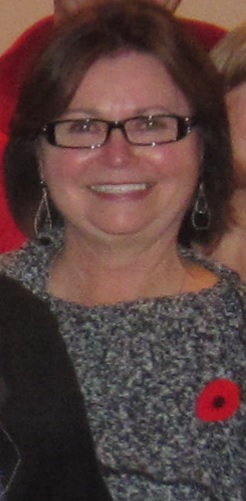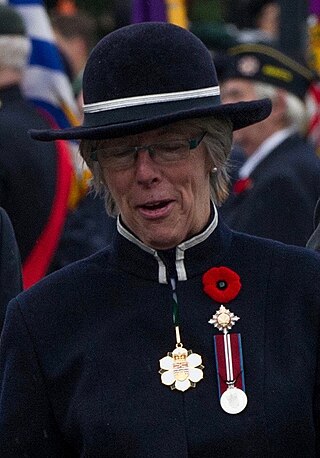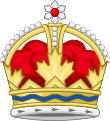
A prime minister or chief of cabinet is the head of the cabinet and the leader of the ministers in the executive branch of government, often in a parliamentary or semi-presidential system. A prime minister is not the head of state, but rather the head of government, serving as the chief of the executive under either a monarch or a president in a republican form of government.

The prime minister of Canada is the head of government of Canada. Under the Westminster system, the prime minister governs with the confidence of a majority of the elected House of Commons; as such, the prime minister typically sits as a member of Parliament (MP) and leads the largest party or a coalition of parties. As first minister, the prime minister selects ministers to form the Cabinet.

The premier of South Australia is the head of government in the state of South Australia, Australia. The Government of South Australia follows the Westminster system, with a Parliament of South Australia acting as the legislature. The premier is appointed by the governor of South Australia, and by modern convention holds office by virtue of their ability to command the support of a majority of members of the lower house of Parliament, the House of Assembly.

Politics of Saint Lucia takes place in the framework of an independent parliamentary democratic constitutional monarchy, with King Charles III as its head of state, represented by a Governor General, who acts on the advice of the prime minister and the cabinet. The prime minister is the leader of the majority party of the house, and the cabinet conducts affairs of state. The Governor General exercises basically ceremonial functions, but residual powers, under the constitution, can be used at the governor general's discretion. The actual power in St. Lucia lies with the prime minister and the cabinet, usually representing the majority party in parliament.
In a parliamentary or semi-presidential system of government, a reserve power, also known as discretionary power, is a power that may be exercised by the head of state without the approval of another branch or part of the government. Unlike in a presidential system of government, the head of state is generally constrained by the cabinet or the legislature in a parliamentary system, and most reserve powers are usable only in certain exceptional circumstances.
A convention, also known as a constitutional convention, is an uncodified tradition that is followed by the institutions of a state. In some states, notably those Commonwealth states that follow the Westminster system and whose political systems derive from British constitutional law, most government functions are guided by constitutional convention rather than by a formal written constitution. In these states, actual distribution of power may be markedly different from those the formal constitutional documents describe. In particular, the formal constitution often confers wide discretionary powers on the head of state that, in practice, are used only on the advice of the head of government, and in some cases not at all.

The premier of Ontario is the head of government of Ontario. Under the Westminster system, the premier governs with the confidence of a majority the elected Legislative Assembly; as such, the premier typically sits as a member of Provincial Parliament (MPP) and leads the largest party or a coalition of parties. As first minister, the premier selects ministers to form the Executive Council, and serves as its chair. Constitutionally, the Crown exercises executive power on the advice of the Executive Council, which is collectively responsible to the legislature.

Thomas Walter Scott was the first premier of Saskatchewan from 1905 to 1916. Scott was Saskatchewan's second longest-serving Premier, serving one continuous term from 1905 to 1916). He led the Saskatchewan Liberal Party in three general elections, winning all three with majority governments before retiring. He was the first of six Liberal Premiers to date. He was succeeded by William Melville Martin. Scott was also the minister of various departments during his tenure as premier. Prior to the creation of Saskatchewan in 1905, Scott was a Member of Parliament in the federal House of Commons of Canada, elected in the general elections of 1900 and 1904.
In Canada, a premier is the head of government of a province or territory. Though the word is merely a synonym for prime minister, it is employed for provincial prime ministers to differentiate them from the prime minister of Canada. There are ten provincial premiers and three territorial premiers. In most provinces and all territories, these persons are styled the Honourable only while in office, unless they are admitted to the King's Privy Council for Canada, in which case they retain the title even after leaving the premiership. In Nova Scotia and Alberta, former premiers are honorary members of the provincial Executive Council and thereby retain the style the Honourable for life.

James Garfield Gardiner was a Canadian farmer, educator, and politician. He served as the fourth premier of Saskatchewan, and as a minister in the Canadian Cabinet.
John Campbell Bowen was a clergyman, insurance broker and long serving politician. He served as an alderman in the City of Edmonton and went on to serve as a member of the Legislative Assembly of Alberta from 1921 to 1926, sitting with the Liberal caucus in opposition. He also briefly led the provincial Liberal party in 1926.

Thomas Robert McInnes or (Gaelic) Tòmas Raibeart Mac Aonghais was a Canadian physician, Member of Parliament, Senator, and the sixth Lieutenant Governor of British Columbia.
A term of office, electoral term, or parliamentary term is the length of time a person serves in a particular elected office. In many jurisdictions there is a defined limit on how long terms of office may be before the officeholder must be subject to re-election. Some jurisdictions exercise term limits, setting a maximum number of terms an individual may hold in a particular office.

Judy May Foote is a former Canadian politician who served as the 14th lieutenant governor of Newfoundland and Labrador from 2018 to 2023. She was the first woman to hold the position.
In Australian political and constitutional terminology, a caretaker government is a government of Australia from when the House of Representatives is dissolved by the Governor-General prior to a general election to a period after the election, until the next ministry is appointed. A caretaker government is expected to conduct itself in accordance with a series of well-defined conventions administered by the Department of the Prime Minister and Cabinet, but there is no law compelling the caretaker government to do so.
A prime minister–designate or premier–designate is the person who is expected to succeed an incumbent as prime minister, or premier, as the result of a general election, winning the leadership of a currently governing party, or being named by the head of state to form a new government.

Judith Isabel Guichon,, is a Canadian rancher and organizer who served as the 29th Lieutenant Governor of British Columbia, serving from 2012 to 2018. She was the viceregal representative of Queen Elizabeth II in the province of British Columbia, and was appointed by Governor General David Johnston on the advice of then-Prime Minister Stephen Harper.
In Malaysian political and constitutional terminology, a caretaker government is a government of Malaysia during a period that starts when the parliament is dissolved by the Yang di-Pertuan Agong before a general election and continues for a period after the election until the next cabinet is formed. A caretaker government is expected to conduct itself under a series of well-defined conventions in maintaining the neutrality of the policy decisions, although there is no law mandating it to do so.










